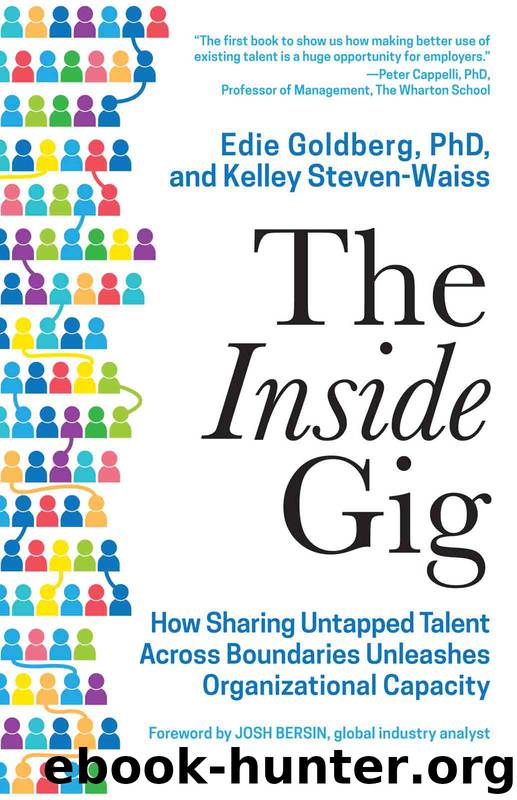The Inside Gig by Edie Goldberg

Author:Edie Goldberg
Language: eng
Format: epub
Publisher: LifeTree Media
Published: 2020-05-15T00:00:00+00:00
After the 2008 financial crisis, many organizations removed layers of management simply to survive, so organizational hierarchies became flattened. For the past decade, organizations have been transitioning to figure out how to work optimally in this new, flatter structure. The flattening of hierarchical structures has had a consequential impact on career promotions. It has made the roles at successively higher levels monumentally larger roles. It was once easy to “climb the rungs of the corporate ladder” because the rungs were close to one another. Now, that ladder is broken, because the rungs are too far apart. Career promotions require not just more experience in the same area, but a breadth of experiences to manage a broader group of individuals. So employees need to focus more on building experiences than on simply taking the next step up an invisible corporate ladder—now you need to navigate a jungle gym of experiences to progress in a career. There’s been a movement from career promotion to career progression.
Traditional organizational structures have only been around for about a century. While they have served us well, it is now time to reconsider each company’s organization design and whether it is serving the needs of the business. Is there an opportunity to rethink how your company is organized? Could it be nimbler and take advantage of a more flexible structure to address new projects, issues or opportunities with more agility as they arise? Do you need to stop talking about career promotion (which relies on hierarchical structures), and speak more about career progression (which helps employees build the mosaic that will ultimately complete the picture of their life)? Is it time to focus less on structure and more on experiences and capability building?
The Inside Gig will enable this type of cross-boundary collaboration. It places these opportunities on a talent platform so that companies can access talent from across the organization, whether they are in a different geography or a different function. Being able to easily form the team you need, when you need it, is the advantage a talent platform brings to any business. Talent platforms search explicitly for skills and experiences and do not look at job titles. Chapter 9, A New Talent Operating Model: Rethinking Ways of Working, will address issues around culture that will support this new agile approach to work.
Despite the advantages to working in dynamic team structures, it won’t be practical to make a wholesale move to these types of structures because baby boomers will resist. They want both the title and the recognition as they move up in the organizational hierarchy. But business leaders need to start thinking in this direction and building in more agility for people to work on projects in teams to meet business needs and then disband and work on other things—just like they do in consulting firms and in Hollywood.
Download
This site does not store any files on its server. We only index and link to content provided by other sites. Please contact the content providers to delete copyright contents if any and email us, we'll remove relevant links or contents immediately.
| Ethics | Etiquette |
| Fashion & Image | Health & Stress |
| Motivation & Self-Improvement | Work Life Balance |
| Workplace Culture |
Tools of Titans by Timothy Ferriss(8218)
Change Your Questions, Change Your Life by Marilee Adams(7635)
Deep Work by Cal Newport(6879)
Man-made Catastrophes and Risk Information Concealment by Dmitry Chernov & Didier Sornette(5921)
Playing to Win_ How Strategy Really Works by A.G. Lafley & Roger L. Martin(5917)
Digital Minimalism by Cal Newport;(5664)
Big Magic: Creative Living Beyond Fear by Elizabeth Gilbert(5610)
The Slight Edge by Jeff Olson(5346)
Ego Is the Enemy by Ryan Holiday(5294)
The Motivation Myth by Jeff Haden(5156)
Stone's Rules by Roger Stone(5026)
The Laws of Human Nature by Robert Greene(4997)
Tuesdays with Morrie by Mitch Albom(4690)
Eat That Frog! by Brian Tracy(4434)
Rising Strong by Brene Brown(4377)
Skin in the Game by Nassim Nicholas Taleb(4162)
Bullshit Jobs by David Graeber(4094)
The Money Culture by Michael Lewis(4076)
Skin in the Game: Hidden Asymmetries in Daily Life by Nassim Nicholas Taleb(3929)
